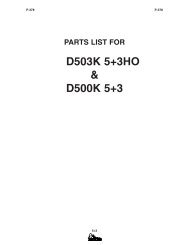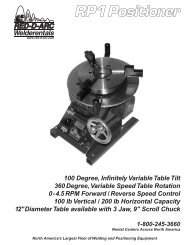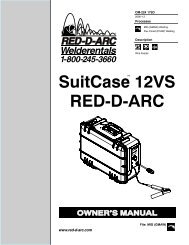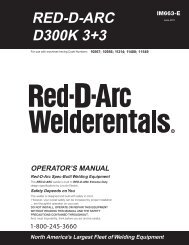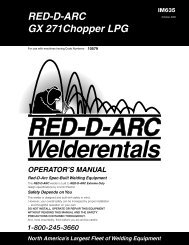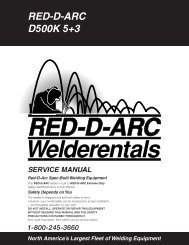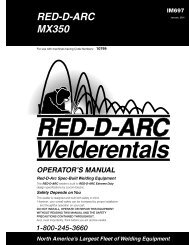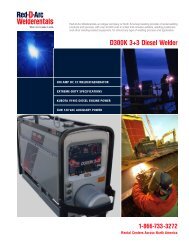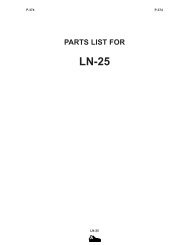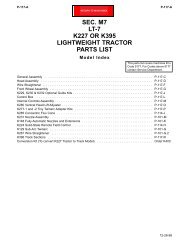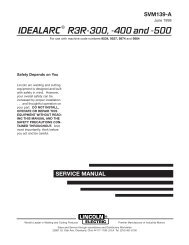RED-D-ARC E500
RED-D-ARC E500
RED-D-ARC E500
You also want an ePaper? Increase the reach of your titles
YUMPU automatically turns print PDFs into web optimized ePapers that Google loves.
B-1<br />
OPERATION<br />
B-1<br />
WARNING<br />
ELECTRIC SHOCK can kill.<br />
• Do not touch electrically live parts<br />
or electrode with skin or wet clothing.<br />
• Insulate yourself from work and ground.<br />
• Always wear dry insulating gloves.<br />
FUMES AND GASES can be dangerous.<br />
• Keep your head out of fumes.<br />
• Use ventilation or exhaust to<br />
• remove fumes from breathing zone.<br />
WELDING SPARKS can cause fire or<br />
explosion.<br />
• Keep flammable material away.<br />
• Do not weld on containers that<br />
have held combustibles.<br />
<strong>ARC</strong> RAYS can burn.<br />
• Wear eye, ear and body protection.<br />
NOTE: The P.C. Board is protected by a moisture<br />
resistant coating. When the welder is operated, this<br />
coating will “bake off” of certain power resistors that<br />
normally operate at high temperatures, emitting some<br />
smoke and odor for a short time. These resistors and<br />
the P.C. Board beneath them may become blackened.<br />
This is a normal occurrence and does not damage the<br />
component or affect the machine performance.<br />
b. Provisions for remote control are standard. A<br />
current control switch on the machine control<br />
panel labeled “Current Control at <strong>E500</strong>” or<br />
“Current Control Remote” is provided for selecting<br />
the desired mode of operation, either at the<br />
machine or remote, Be certain the machine<br />
remote switch is in the machine position, unless<br />
a remote control is connected.<br />
c. The “Arc Force Control”, located on the right side<br />
of the front control panel, is calibrated from one<br />
to ten. Lower settings will provide less short circuit<br />
current and a softer arc. A setting that is too<br />
low may cause the electrode to stick in the puddle.<br />
Higher settings will provide a higher short<br />
circuit current, a more forceful arc, and possibly<br />
more spatter. For most welding, the dial should<br />
be set at approximately mid range (5 – 6).<br />
Adjustment up or down can then be made<br />
depending on the electrode, procedures, and<br />
operator preference. For most TIG welding applications<br />
adjust this control to minimum for best<br />
operating characteristics.<br />
115 VAC Duplex Receptacle (Code 10649 only)<br />
The duplex receptacle is located near the output<br />
studs and is protected by a 15 amp circuit breaker.<br />
115 VAC GFCI Receptacle (Codes 11042 and above)<br />
The GFCI receptacle is located near the output studs<br />
and is protected by a 15 amp circuit breaker.<br />
OPTIONAL EQUIPMENT<br />
1. Undercarriage – (K817, K817R) includes a spring<br />
loaded handle for hand towing and a choice of<br />
wheels.<br />
2. Remote Control - Supplied by Red-D-Arc.<br />
NOTE: The cooling fan on this unit is controlled by a<br />
thermostat to operate only when it is needed.<br />
1. To Start the Welder, move the “Power” switch to<br />
“On”. This starts the welder and lights the white pilot<br />
light on the machine control panel. This light indicates<br />
that the line contactor is energized).<br />
2. Setting Welding Current<br />
a. The “Current Control” dials on the front of the<br />
machine indicates the output current at the<br />
NEMA arc voltage. The “A” range controls the<br />
current over about 1/2 of the range of the “B”<br />
range. A toggle switch on the control panel<br />
allows selection of the desired range. The output<br />
control can be adjusted while welding.<br />
<strong>E500</strong>





